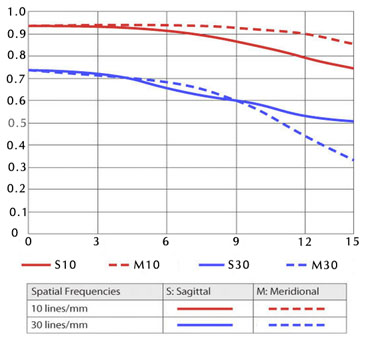 |
| A typical MTF chart - courtesy of Nikon UK. |
Modulation Transfer Function (MTF) is a basically a measurement of the contrast between black and white lines of various line frequencies. This provides an objective measurement of resolution and contrast, and hence of the performance of a lens. Specialized resolution targets (such as ISO-12233), instrumentation and software are employed to measure the contrast at several spatial frequencies - typically defined as line pairs per millimetre (lp/mm). The resulting MTF graphs characterize contrast and sharpness. They do not provide measures of colour balance, flare or distortion.
MTF charts can be useful when evaluating lens quality, particularly sharpness, but they represent only one measure of quality. Focus speed, colour saturation, build quality and suitability to a particular objective must also be considered. It is also worth noting that MTF charts do not have a standard format and my vary from one manufacturer to another.
MTF contrast is a measure of the remaining percentage of original black and white contrast after projection. This percentage is typically shown on the vertical axis of a graph with the distance from the image centre (in mm) on the horizontal axis. Multiple measurements are then plotted at the different spatial frequencies (lp/mm). A result of 100% MTF would represent a perfect lens but is of course unattainable. 0% MTF would represent no detectable contrast difference. For each frequency there are various basic measurements, sagittal MTF (which uses straight lines) and tangential MTF (which uses concentric circles) and meridonial MTF (which uses straight lines positioned diagonally across the centre of a lens). Spatial frequencies are typically 10lp/mm and 30lp/mm. Measurements made at various apertures may sometimes be show on a single graph. Examples of measurements of a 300mm lens at f/2.8 and f/8 are shown below.
 |
| From left to right, progressive loss of ability to distinguish black and white lines. |
A high quality lens with excellent resolution and contrast will reveal clear boundaries between blacks and whites, as seen in the left side of the image above. It will be able to distinguish clearly lines spaced at 30 lp/mm for both sagittal, tangential and meridonial lines. A lower resolution lens with optical flaws will reveal a smoother transition from blacks to whites, indicating lower contrast. Such a lens is likely to blur line at 30 lp/mm in to a more uniform grey mass - as shown to the right in the image above.